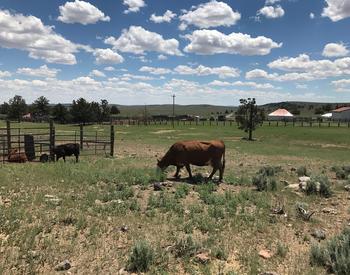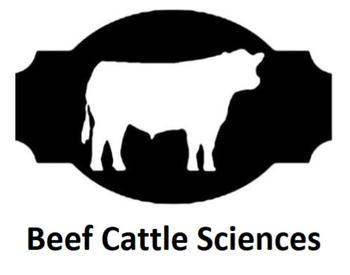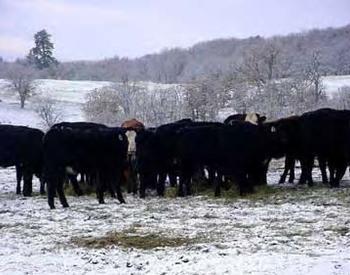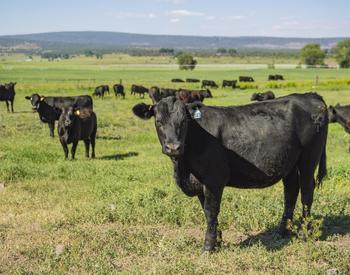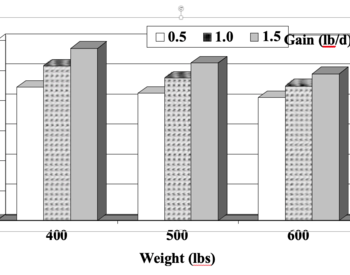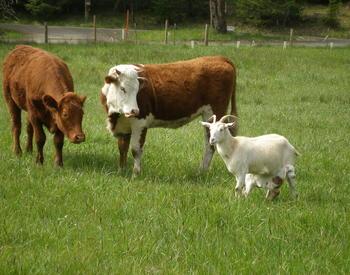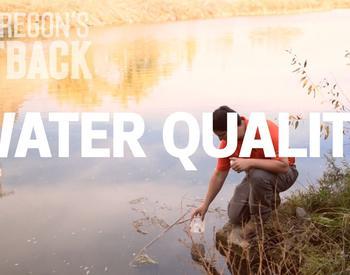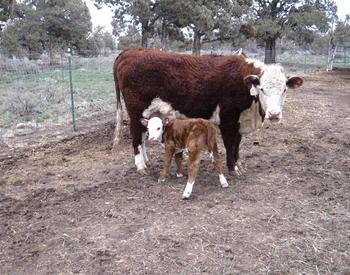Introduction
On average, the U.S. cattle industry loses more than $1 billion every year due to death caused by health conditions, such as respiratory, digestive, and metabolic problems. Death loss, however, is not the only, and often not the most significant, economic cost associated with health issues. As an example, bovine respiratory disease and shipping fever complex cost the beef industry approximately $500 million annually. These economic losses include, besides cattle mortality, costs associated with wasted feed resources, purchase of pharmaceuticals, and reduced performance of morbid cattle. Therefore, cattle health highly determines the success and profitability of beef operations, thus beef producers should actively monitor the health management of the herd.
Working together with a veterinarian is indispensable, but understanding some of the concepts associated with cattle health will further allow beef producers to improve their cattle health programs. This article will provide basic information regarding health management and the immune system of cattle.
The Immune System
The immune system is responsible for recognizing, resisting, and eliminating health challenges, including pathogens, injuries, parasites, and stress. The immune system should react and work fast when necessary so the productive functions of the animal are not impaired. Therefore, a competent immune system is fundamental for optimal cattle performance. In general, the immune system can be separated into two components: the innate system and the adaptive system (Figure 1).
Although both systems have different features and functions, they are highly integrated and work in harmony to provide adequate immune protection to the animal.
Innate Immune System
This system is the first line of defense against any health challenge. It is constituted by physical barriers and cellular components that do not react specifically to the health challenge or disease that the animal acquires (Figure 1). This means that the innate immune system will respond similarly to different pathogens, injuries, or stressors, but often not efficiently enough to resist and eliminate complex disease conditions. However, the innate immune system is triggered almost immediately after the animal is exposed to health challenges. This characteristic of the innate system provides the time required by the adaptive system to develop a specific and more efficient response, which may take up to several days.
The major components of the innate immune system are:
- Physical Barriers - Includes the skin, mucosa, and fluids such as saliva and tears. The main function of physical barriers is to prevent pathogens such as viruses, bacteria, and parasites from entering the body and causing infection.
- Cellular components – Mainly constituted by white blood cells that provide protection by ingesting and killing pathogens that eventually enter the body. These cells are also responsible for secreting substances that will further enhance the innate immune response.
- Inflammatory response –When pathogens enter the body, white blood cells are mobilized to track and attack them. If the pathogen is not eliminated quickly, white blood cells start producing several substances that triggers an inflammatory response that is needed to recruit additional immune cells to fight the infection. If the infection occurs because of an injury that breaks the skin, the innate immune system enhances blood flow to the injury site to increase the number of white blood cells in that area, which is why the injured area rapidly becomes red, warm, swollen, and very sensitive to touch. If the invading pathogen not rapidly eliminated and the inflammation process persists, it leads to fever. Increased body temperature helps with infection control and elimination because some viruses and bacteria do not survive higher temperatures, whereas many immunological processes become further stimulated. However, prolonged inflammation and fever are harmful to the animal’s overall health; therefore the infection needs to be eliminated quickly to prevent further immune complications.
If the health challenge is not eliminated by the innate immune system, the adaptive system takes over. This transition is mediated by some of the white blood cells from the innate system, which “introduces” the foreign agent to specific cells from the adaptive system for activation of this immune response.
Adaptive Immune System
This system adapts and builds a precise immune response for each challenge that the animal encounters. However, it takes longer to become effective compared to the innate immune system, sometimes up to several days following the infection. The adaptive system is characterized by production of antibodies that are specific for each foreign pathogen, and also by its “memory” feature. If the animal is infected a second time by a pathogen, the adaptive system remembers the first infection and elicits a faster and stronger response to eliminate the pathogen (Figure 2). This “memory” feature is the foundation for the development of vaccines to protect animals from specific diseases. The adaptive system can be further divided into an antibody response and a cell-mediated response (Figure 1). The major components of the adaptive immune system are:
- Lymphoid organs – These organs are responsible for producing and activating the immune cells that mediate the adaptive immune system. In general, the bone marrow produces B cells, whereas the thymus produces the T cells. Both B and T cells are activated in the spleen or lymph nodes, where they encounter the pathogen “presented” by white blood cells from the innate immune system.
- B cells – These are the cells responsible for secreting antibodies. When the B cell encounters the pathogen, it begins to divide and produce antibodies that are specific for that pathogen. These antibodies will attach to every target pathogen that they encounter, and will either neutralize it, or “mark” the pathogen for ingestion or destruction by other cells, such as white blood cells, T cells, and even B cells. Some B cells are also responsible for the “memory” feature of the adaptive immune system. These “memory” cells will record the pathogen’s genetic composition, and register which antibody needs to be produced to eliminate the pathogen.
- T cells – They are responsible for eliminating cells containing the pathogen (cell- mediated response). Similarly to B cells, the T cells begin to multiply and become specific to the “presented” pathogen. When activated T cells encounter white blood cells and B cells that have ingested the specific pathogen they attack and eliminate the whole cell-pathogen complex.
- Active and passive immunity – Immunity is the resistance of the animal to a specific disease. Active immunity is acquired when the animal is infected by a specific pathogen, creates a “memory” against it, and successfully eliminates the disease and pathogen. The next time the animal is infected by the pathogen, the adaptive immune response will be faster and stronger (Figure 2), quickly eliminating the pathogen and preventing the disease. A common example is chicken pox in humans; once you have it you’ll never have it again. Vaccination is also an example of active immunity. By injecting the animal with a killed or weakened pathogen, which won’t be harmful enough to develop the disease, the immune system creates the “memory” and learns how to fight it if an infection occurs. Passive immunity occurs when the animal receives antibodies from an external source, such as another animal. The classical example of passive immunity is the transfer of antibodies from the cow to the calf via colostrum. This transfer is extremely important to newborn calves because their immune system is not mature enough to develop its own antibodies. The calf should be immune to most of the pathogens present in the environment because the dam has already been exposed to them and developed protective antibodies. Another example of passive immunity is the administration of specific antiserum or antitoxin to sick cattle or calves that did not receive enough colostrum.
Managing Cattle Health
In commercial beef operations, cattle are frequently exposed to health challenges. These can be bacteria, viruses, parasites, and toxins coming from the feed, air, water, wildlife, other cattle, and even humans. Stress is also an important factor regarding cattle health. Extreme temperatures, handling, transportation, weaning, and comingling are stressors that can suppress the immune system of cattle, but also trigger inflammatory responses.
Maintaining cattle in good health is not only important for animal well-being, but also has implications on animal productivity. The immune system, as well as any other body functions, requires a significant amount of nutrients to work properly. When the animal is infected by a pathogen, a significant amount of the consumed energy and protein that were supposed to support productive functions, such as growth, reproduction, lactation, are shifted to support the immune response. These nutrients are required for production of white blood cells, support the inflammation process, multiplication of T and B cells, antibody synthesis, and many other immune processes. Therefore, maintaining cattle in good health will improve nutrient utilization and productivity. Similarly, cattle should always be maintained in adequate nutritional status so their immune system can work properly when needed. Some management considerations to improve the immune system of cattle are:
- Nutrition – Energy and protein are required for every single process within the body, including the immune system. Energy serves as fuel for the synthesis and function of immune cells, whereas protein regulates and serves as structural component for cells and antibodies. Without proper energy and protein intake, the immune system and any immune response becomes impaired. Minerals are required for proper function of the immune components, such as pathogen recognition and antibody response. Although several minerals are important for overall body function, selenium, zinc, copper, and chromium are specifically important for the immune system and should always be offered to cattle in amounts that supply their requirements. Vitamins A, B6, B12, C, and E are also essential for proper immune function, and their roles typically overlap with those of minerals. Cattle should always receive adequate amounts of vitamins A and E in the diet, whereas supplementation of vitamins B and C are often not required because rumen bugs and body tissues, respectively, produce sufficient amounts of these vitamins.
- Reducing stress – Stressful situations also have negative effects on the immune system. Common stressors in beef operations are heat/cold stress, frequent handling, transport, and weaning. Prolonged stress, such as during extremely hot or cold temperatures or after weaning, can suppress the immune response; therefore cattle would be more susceptible to diseases. Conversely, short-term stress, such as transport and handling, can activate the immune response, specifically the innate system. Therefore, reducing the amount of stress to which cattle are exposed will benefit their health and, consequently, the productivity of the beef operation. During mandatory procedures, such as transport and weaning, cattle should be in adequate health and nutritional status to prevent further immune complications.
- Vaccination – A well-planned vaccination calendar is essential for good health of the herd. Producers should work closely with a local veterinarian to prepare the vaccination program ahead of time. Cattle should be in adequate health, proper nutritional status, and under no or low-stress to maximize the effectiveness of the vaccines.
- Other considerations – Newborn calves should always have adequate access to colostrum. Producers should make sure that pens, working facilities, lots, feed bunks, and water troughs are properly clean to prevent accumulation and growth of pathogens. Feeds should also be inspected for mold, excessive moisture, and toxins. Recently purchased cattle should be evaluated and, if necessary, quarantined to prevent foreign pathogens from entering the operation. Interactions between cattle, wildlife, and other livestock species should also be monitored to prevent spreading of interspecies diseases.
Conclusions
The immune system is a complex group of biological processes responsible for maintaining a healthy animal. An impaired immune system is detrimental not only to animal well-being, but also to animal productivity. Beef producers should always seek management alternatives that enhance animal health, such as proper nutrition, low-stress management, and an adequate vaccination program. Understanding some of the basic features of the immune system will allow producers to better plan and handle these alternatives, and consequently enhance the efficiency of their operations.
References
Abbas, A. K., and A. H. Lichtman. 2007. Cellular and Molecular Immunology, 6th edition. Saunders, Philadelphia, PA.
Carroll, J. A., and N. E. Forsberg. 2007. Vet.
Clin. Food. Anim. 23:105-149.
England, J. J. 2008. In: Cow-Calf Management Guide, CL600.
Richley, E. J. 2003. The Immune System. University of Florida - IFAS Extension.
This document is part of the Oregon State University - Beef Cattle Library. Prior to acceptance, this document was anonymously reviewed by two experts in the area.
